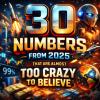
Breaking News
 Trump Says Netanyahu Pardon "On Its Way", Israeli President Says Otherwise
Trump Says Netanyahu Pardon "On Its Way", Israeli President Says Otherwise
 CIA Drone Carried Out First Known Land Strike On Venezuela
CIA Drone Carried Out First Known Land Strike On Venezuela
 30 Numbers From 2025 That Are Almost Too Crazy To Believe
30 Numbers From 2025 That Are Almost Too Crazy To Believe
 You Probably Aren't Going Insane, Just Everything Else Is
You Probably Aren't Going Insane, Just Everything Else Is
Top Tech News
 EngineAI T800: Born to Disrupt! #EngineAI #robotics #newtechnology #newproduct
EngineAI T800: Born to Disrupt! #EngineAI #robotics #newtechnology #newproduct
 This Silicon Anode Breakthrough Could Mark A Turning Point For EV Batteries [Update]
This Silicon Anode Breakthrough Could Mark A Turning Point For EV Batteries [Update]
 Travel gadget promises to dry and iron your clothes – totally hands-free
Travel gadget promises to dry and iron your clothes – totally hands-free
 Perfect Aircrete, Kitchen Ingredients.
Perfect Aircrete, Kitchen Ingredients.
 Futuristic pixel-raising display lets you feel what's onscreen
Futuristic pixel-raising display lets you feel what's onscreen
 Cutting-Edge Facility Generates Pure Water and Hydrogen Fuel from Seawater for Mere Pennies
Cutting-Edge Facility Generates Pure Water and Hydrogen Fuel from Seawater for Mere Pennies
 This tiny dev board is packed with features for ambitious makers
This tiny dev board is packed with features for ambitious makers
 Scientists Discover Gel to Regrow Tooth Enamel
Scientists Discover Gel to Regrow Tooth Enamel
 Vitamin C and Dandelion Root Killing Cancer Cells -- as Former CDC Director Calls for COVID-19...
Vitamin C and Dandelion Root Killing Cancer Cells -- as Former CDC Director Calls for COVID-19...
 Galactic Brain: US firm plans space-based data centers, power grid to challenge China
Galactic Brain: US firm plans space-based data centers, power grid to challenge China
Scientists Turn Nuclear Waste into Diamond Batteries That'll Last for Thousands of Years

Nuclear energy is carbon free, which makes it an attractive and practical alternative to fossil fuels, as it doesn't contribute to global warming. We also have the infrastructure for it already in place. It's nuclear waste that makes fission bad for the environment. And it lasts for so long, some isotopes for thousands of years. Nuclear fuel is comprised of ceramic pellets of uranium-235 placed within metal rods. After fission takes place, two radioactive isotopes are left over: cesium-137 and strontium-90.
These each have half-lives of 30 years, meaning the radiation will be half gone by that time. Transuranic wastes, such as Plutonium-239, are also created in the process. This has a half-life of 24,000 years. These materials are highly radioactive, making them extremely dangerous to handle, even with short-term exposure.
The typical nuclear power plant creates about 2,300 tons of waste annually. 99 reactors are currently employed in the United States. That's a lot of waste per year. The US is currently stockpiling 75,000 tons of nuclear waste. It is carefully stored and maintained. However, just like anything else it is vulnerable to natural disasters, human error, even terrorism. Storage is also costly. American taxpayers are on the hook for tens of millions of dollars.
So what can be done? Researchers at the University of Bristol in the UK have a solution. Geochemist Tom Scott and colleagues have invented a method to encapsulate nuclear waste within diamonds, which as a battery, can provide a clean energy supply lasting in some cases, thousands of years.



